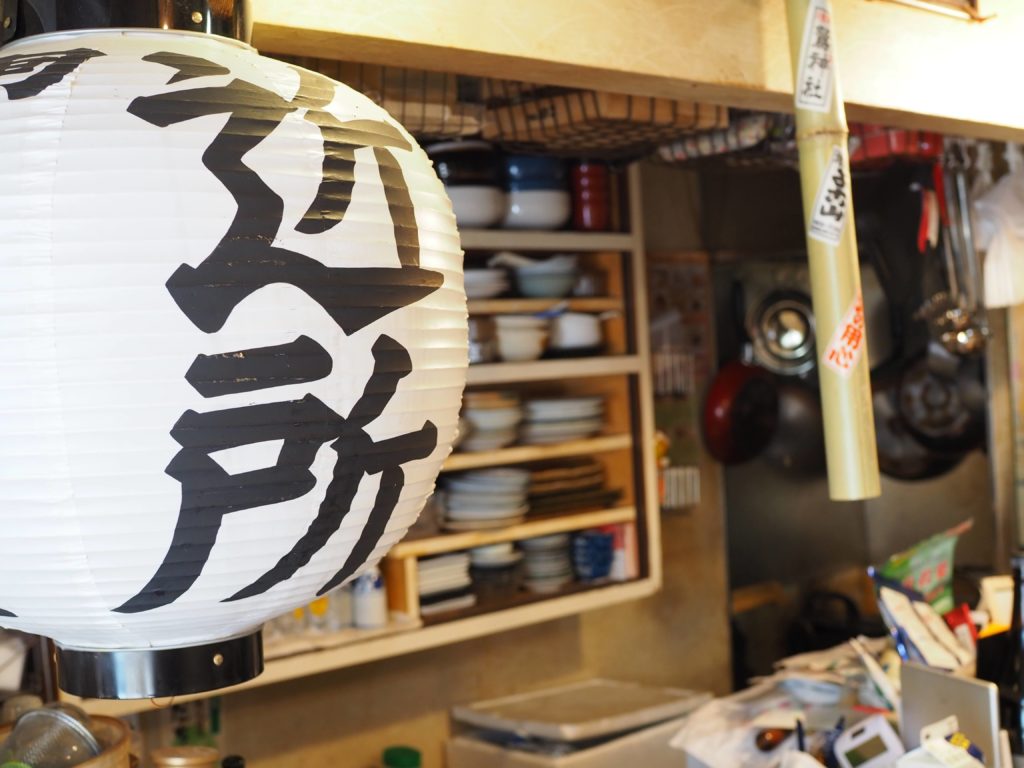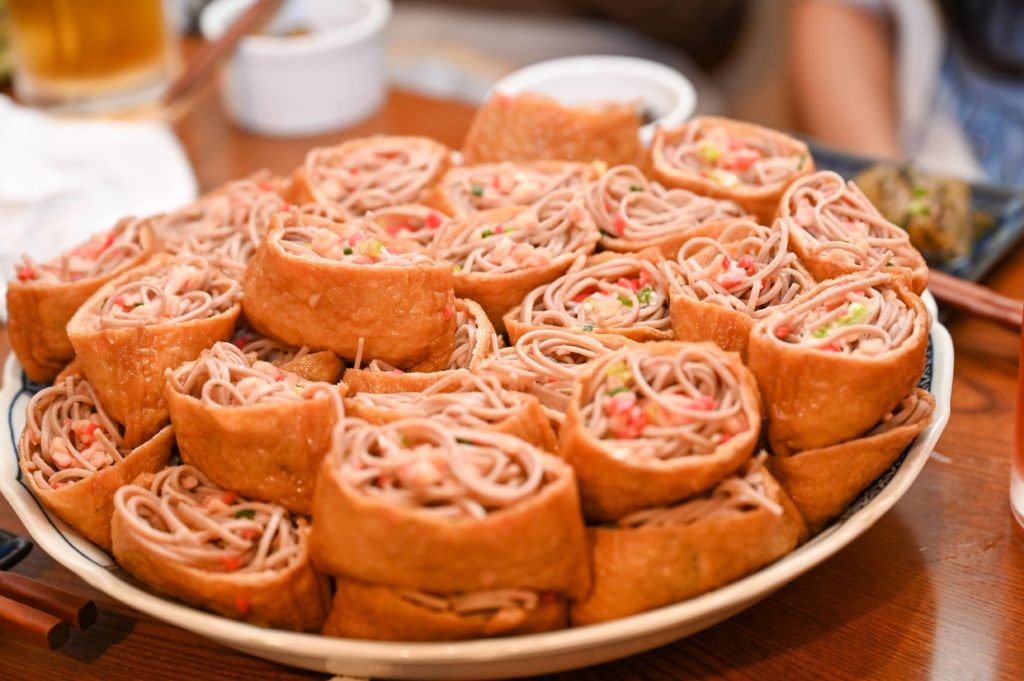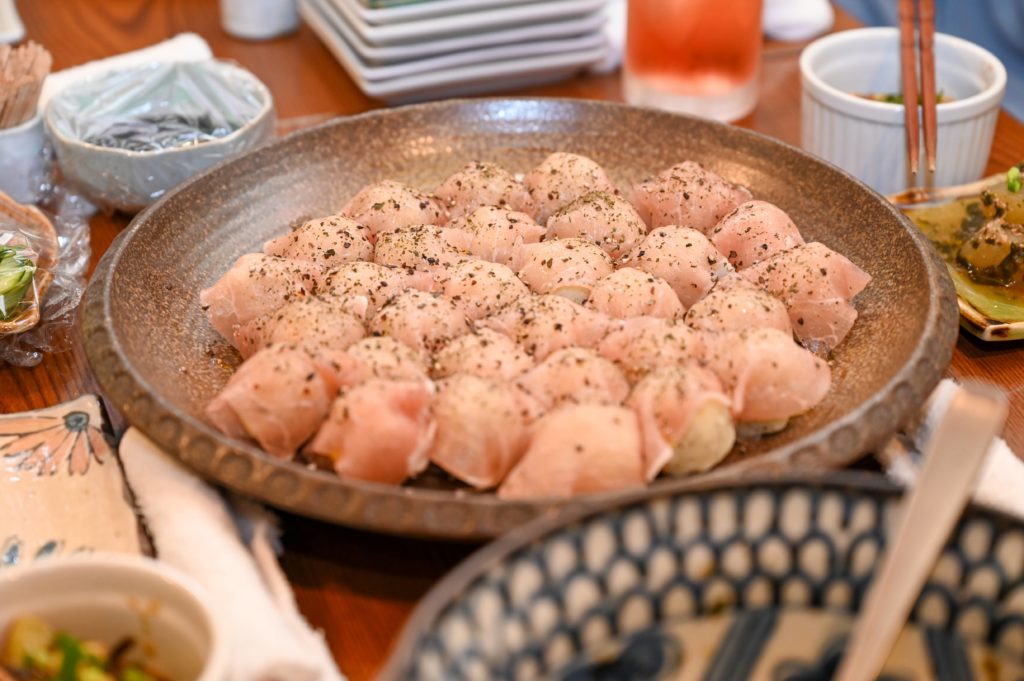Japanese Food History and Culture
A Japanese Izakaya: Interview with Sanae from “Kinjo”
This is the second part of a two-part series about the Japanese izakaya. In this interview, we get a look behind the counter of an old town izakaya. The first part traces the origins and customs of this mainstay of Japanese nightlife.
In East Tōkyō, some parts of the shitamachi (下町) old town are still standing, and they have an older, more nostalgic ambiance compared to the younger and more modern Shinjuku and Shibuya areas. To get a glimpse behind the counter of one of the many small businesses one can find in the old town, we’ve met with the owner of Kinjo (近所, “Neighborhood”), an izakaya in the Machiya area.
About Kinjo
Gochisō History: Thank you very much for having us! First, could you tell us a bit about yourself?
Sanae-san (早苗さん): Well, where should I start…? *laughs* I am Sanae Takahashi, born and raised in Arakawa ward, Tōkyō prefecture. I have been the owner and keeper of my own izakaya, Kinjo, for 23 years now.
GH: Can you tell us a bit more about Kinjo? What would be the concept of your izakaya?
Sanae: Mmh… Well, it is a shop rooted in the neighborhood. The full name could be Neighborhood seasonal home cooking (旬家庭料理近所, shun katei ryōri kinjo). So the concept would be cooking with fresh, in-season locally available vegetables, fishes and ingredients.
GH: Why did you decide to open your own izakaya?
Sanae: I always liked cooking, and my entourage was pretty supportive. So after trying various jobs and companies when I was younger, I decided to seriously dedicate myself to my own business. I worked in different places to get experience and followed food coordinator classes. After working in several restaurants for a set period of time, I got my cooking license to open my own establishment.
At first, I wanted to open an osōzai shop (お惣菜, prepared food). This street is on the way to and from the local preschool, so along it there are shops selling prepared dishes to mothers. There’s a butcher’s shop selling tonkatsu that’s enjoying a bit of fame: every time a TV crew comes around those parts to showcase local businesses, they are on it. Next to it, there’s a tōfu shop that is also friendly and quite successful. Mothers with kids in tow buy dishes along the way back home. So I thought an osōzai shop would make sense.
However, it is quite strenuous work, especially by yourself, and my family advised against opening this kind of shop. They told me I would get better margins selling alcohol as well. So I thought “Why not open an izakaya then?”. And that’s how Kinjo came to be.

GH: I see! Was it easy setting up shop?
Sanae: At the beginning, I didn’t have any capital, so I borrowed from my parents and relatives. Through an acquaintance of my father, I found a location to set up shop. It was in an old building that was set to be taken down in 2-3 years time. This meant that I would have to move out eventually, but in the meantime the rent would be very low. Moreover, since it was a former restaurant, it was inuki (居抜き), meaning all amenities were already there and I just had to move in.
However, there were administrative hurdles, and I had waited for 2 months without being able to move in. At the same time, I really liked the current location more. I actually wanted to set up shop here at first, but the real estate agent had told me the landlord didn’t want a restaurant in the building. While I was waiting though, the realtor changed so I decided to ask again. This time, I could speak directly with the building owner, who told me that because she had close ties with a nearby rāmen shop, she wanted to avoid creating competition. That is why she had instructed the real estate company she didn’t want a Chinese or rāmen restaurant in the building, but she didn’t have any issue with an izakaya. So I canceled the previous arrangement and moved here.
GH: Then all’s well that ends well!
Sanae: Still, I had to do my fair share of negotiating. It wasn’t always easy getting things from my landlord! *laughs* For instance, the toilets were washiki (和式) squatting toilets, had to modernize them, things like that.
GH: What does a typical working day look like? How often do you open?
Sanae: In my time, the general work mentality was that you didn’t take more than one day off per week. I was working 6 days per week, and sometimes had to meet with customers on off days, so it was quite demanding! However, recently the work culture in Japan has been shifting, and shorter work weeks have become more common.

This mentality was also reflected in the drinking habits of the customers. Our part of the town had quite a lot of blue collar workers. After work, it was common for them to pub crawl to various izakaya and drink copious amounts of alcohol. This culture has also been dying down, meaning izakaya have been steadily losing customers.
The official opening hours of Kinjo are 5pm to midnight. But I’ve almost never managed to close by midnight! Maybe once per year, but otherwise the izakaya stays open until typically 2am. Moreover, for more than 15 years, I didn’t get once an evening without customers, what we call ocha o hiku (お茶を引く, to grind the tea; this was the default task for idle store employees, meaning there is nothing else to do).1
Then, they started building a cultural center next door, so I was open for lunch as well. The idea was to get construction workers to take their lunch here during their break. However, as I’m working by myself, it was quite difficult having a fast enough turnaround. Moreover, I also started serving ice cream for the neighborhood kids. So the kids would sometimes come at lunch time, and while I’m taking care of the ice, everything else stops, right? That wasn’t easy. *laughs*
GH: So all by yourself, you were working lunch and dinner?
Sanae: I was able to do that only because evenings had become quite slow. Since it wasn’t that busy anymore, I tried to compensate by getting more revenue during day time. When I knew I had a busy evening coming, I wasn’t doing lunch, that wouldn’t be sustainable. Before, when you saw an izakaya serving lunch, this probably meant business was slow in the evenings. However, with the evolution of the service industry in Japan, this might not hold true anymore nowadays.
“At times, I also pick food I would like to eat!”
GH: How about preparation time? You have to replenish stocks and prepare the food, right?
Sanae: This depends on what I’m preparing. Some dishes I can prepare the day before, when there is a lull in the work. For instance, boiling daikon for making oden to be served the following day. If I’m particularly busy one evening, I might have to wake up early the next day and prepare everything before the opening. So it’s pretty variable. In general, I try to stagger preparations over several days, as cooking everything on the same day is quite difficult.
Then, I have to think about ingredient availability. Since I’m getting my ingredients in supermarkets and stalls in the area, I have to keep in mind what is available where, what is in season, and so on. Each supermarket will have certain foods discounted on certain days of the week, so I also keep that in mind when deciding my route for shopping.
GH: So this means your menu is also influenced by what you can find?
Sanae: Exactly. Sometimes, I find some discounted ingredients at the supermarket that I then incorporate into today’s or tomorrow’s menu. At times, I also pick food I would like to eat! *laughs* Then, there is leftover stock that I need to use. So it’s a bit like a puzzle, I put all those pieces together to decide what’s on the menu for the day.
And then, there are special occasions or requests. When I know regulars are coming or for events, I plan in advance what I will serve and when I’ll do the preparations for each dish.
GH: So you have a full repertoire of recipes in your head, and you select what you need on the day?
Sanae: At the beginning, I was planning the entire menu and writing down a full shopping list every time. But with experience, I became more flexible and started improvising more.
I was also scouring magazines and books to try to emulate the successful shops that were displayed. Copying recipes that look good while adding my own touch, like swapping salt with shōyu, or adding miso. Reusing old recipes with a more modern feel, this kind of stuff.
GH: So your menu changes everyday?
Sanae: For the most part, yes. I try to keep a balanced menu, so I’m mostly swapping equivalent dishes, like serving edamame beans instead of soramame, or spaghetti instead of rāmen. I have a fixed menu as well, and I was keeping everything in stock, but recently I’ve become more slack with it, and might offer substitutes instead if asked.
GH: Do you have a dish that is popular, that could be considered Kinjo’s specialty?
Sanae: The soba inari! (NB: the soba inari is an abura age fried tōfu pouch filled with soba noodles) Everyone likes it, and it is often requested. The kuro karē (黒カレー, black curry) and hayashi raisu (ハヤシライス, hashed beef rice) are also quite popular.
GH: So we talked about setting up the shop and the day-to-day shopkeeping. Would you have any advice for young people starting their own izakaya?


Sanae: This might have changed since I was a beginner, but I’d say communication is key. When I am behind the counter, rather than talking, it’s more about being a good listener. You still have to be able to keep a conversation going, but you are not dictating the pace and topic. So being able to listen well and understand what you should reply or say is a very important skill. This also means knowing when you should include everyone in the conversation, or talk more face-to-face with a customer.
Sometimes, this also means managing conflicts when they arise. If two customers are in a heated conversation, I get in between and have to judge how to defuse the situation. Whom should I ask to leave? What can I tell them without overstepping boundaries? That is also part of the job.
Older people especially have a tendency to drink a lot. They spend the evening hopping between places, and as some of them get angry when drunk, they can be a handful when they end up here.
GH: So food and drinks are the basis, but the atmosphere of the izakaya is also an important part of the place?
Sanae: Absolutely! People come here to have a chat. They want to discuss. Well, sometimes a customer would come, keep to themselves and read a book. In that case, I’m never sure if I should strike up the conversation or not…
GH: Any parts of the job that are difficult or you do not like?
Sanae: When I was younger, I would have older people giving me unrequested advice and then ask for discounts in return for their “wisdom”! In rare instances, customers could have unreasonable requests and I had to deal with them while still attending the other patrons. It is only with time that I learned to manage both difficult customers and my own workload.
GH: In spite of all this, you’ve managed Kinjo on your own for 23 years now. That’s very impressive! Any plans for the future?
Sanae: Mmh… Especially since the COVID-19 outbreak, I’ve had time to think about looking for new things to try. Maybe do online food deliveries, or change the layout of the izakaya… Who knows!
GH: In any case, we are looking forward to it! Thank you very much for your time, and we’ll be back soon for some soba inari! Any closing words?
Sanae: Thank you! Please come visit, but not too many at the same time!